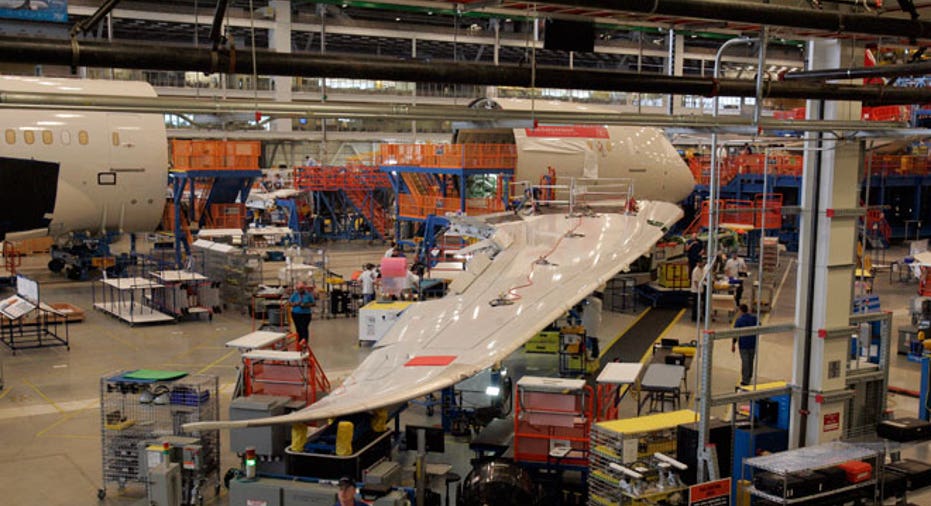After 'Severe Fire Damage' Found, Boeing Incident Sparks Concern Over 787 Safety

Boeing (NYSE:BA) is undergoing the second probe by U.S. safety officials in just six months related to fires on its new 787 Dreamliner.
The National Transportation Safety Board, which began investigating reports on Monday of smoke on a grounded Boeing 787 operated by Japan Airlines at Boston’s Logan Airport, said it found "severe fire damage" on the auxiliary power unit battery.
Preliminary reports indicate the airplane maintenance and cleaning personnel were on the aircraft with the battery pack in operation just prior to detecting smoke in the cabin.
Rescue personnel located the fire in the electronics and equipment bay near the APU battery box. The fire was extinguished about 40 minutes after arrival of the first rescue, according to the NTSB report. One firefighter sustained minor injuries.
The board sent another investigator to the scene on Tuesday following reports that United Airlines (NYSE:UAL) found wiring problems onboard one of its Dreamliners, according to a report by The Wall Street Journal citing a person close to the matter.
The NTSB is now looking into airworthiness and fire on the 787 as well as airport emergency response at Logan. In addition to Boeing and the Federal Aviation Administration, Japan's Transport Safety Board has also been asked to assist in the investigation and will represent Japan Airlines.
Boeing has not commented on the fire, citing the ongoing NTSB probe.
Earlier on Tuesday in a separate incident, a different 787 also operated by Japan Airlines and destined for Tokyo, was sent back to the gate just prior to takeoff after 40 gallons of oil were spilled on the tarmac.
Boeing said it is working with its customer, Japan Airlines, on the leak and the FAA said it is "looking into" the cause of it.
Both incidents, as well as United's reported findings, have prompted new concerns regarding the safety of Boeing’s new fuel-efficient jet.
“The NTSB has dispatched an investigator to Boston,” the group said in a statement. “Based on a review of the factual information gathered, the NTSB will determine the extent of its investigation.”
The fire comes six months after a newly-built 787 destined for Air India’s fleet was probed when its General Electric (NYSE:GE) GEnx engine caught fire and spewed debris following a test. Boeing at the time confirmed that it was “working closely” with the NTSB on the incident, which has since been resolved and deemed an accident.
Also last summer, Dreamliner jets owned by All Nippon Airways were grounded because of corrosion found in engines during testing. The twin-aisle aircraft, which seats up to 290 passengers, made its first passenger flight in October with the Japanese carrier.
Boeing had said that problems related to the All Nippon Airways jets were caused by changes to a manufacturing process. The airline began returning those jets to service shortly thereafter.
The Dreamliner, Boeing’s new fuel-efficient highly-desired jumbo jet, has been plagued by problems since first launching in 2011. All Nippon Airways, which owns 11 of the latest-generation 787s, has also reported problems with the landing gear.
While the jet’s hiccups have raised concerns, flight safety continues to improve as airlines modernize their fleets and acquire safer in-flight mechanisms. Last week, the Aviation Safety Network said 2012 was the safest year for civil aviation since 1945 with just 23 fatal accidents.
At the same time, the company was slapped with a downgrade by BB&T Capital Markets, which lowered the Illinois-based jet maker to “hold” from “buy” citing the Boston fire incident.
“Electrical problems with new aircraft are to be expected,” BB&T analyst Carter Leake said. “Problems that result in fires or in flight diversions are not.”
Commercial aircraft are designed so that the system can automatically detect, isolate and quarantine a problem before it reaches the level of overheating, Leake said. Without further information from Boeing, however, Leake said it appears as though the architecture failed on Monday.
“We can only assume the other three electrical incidents are related to similar failings of the system to handle electrical anomalies in proper fashion,” he said. “As such, we believe it prudent to step to the sidelines until this very serious issue is sorted out.”
Jets of this size are operated using millions of lines of code, more than 50 miles of wiring, 50,000 connectors and hardware. The cause of the fire could be derived from any one of these components, with some easier to discover than others.
While BB&T continues to believe in Boeing’s leadership in the market and long-term competitive positioning, it notes that the current challenge will likely keep Boeing’s stock at the current range or lower until it can prove the problems are fully resolved.